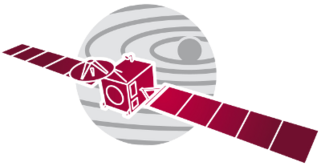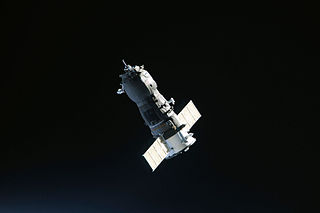Related Research Articles

A comet is an icy, small Solar System body that, when passing close to the Sun, warms and begins to release gases, a process that is called outgassing. This produces a visible atmosphere or coma, and sometimes also a tail. These phenomena are due to the effects of solar radiation and the solar wind acting upon the nucleus of the comet. Comet nuclei range from a few hundred meters to tens of kilometers across and are composed of loose collections of ice, dust, and small rocky particles. The coma may be up to 15 times Earth's diameter, while the tail may stretch beyond one astronomical unit. If sufficiently bright, a comet may be seen from Earth without the aid of a telescope and may subtend an arc of 30° across the sky. Comets have been observed and recorded since ancient times by many cultures and religions.

Giotto was a European robotic spacecraft mission from the European Space Agency. The spacecraft flew by and studied Halley's Comet and in doing so became the first spacecraft to make close up observations of a comet. On 13 March 1986, the spacecraft succeeded in approaching Halley's nucleus at a distance of 596 kilometers. It was named after the Early Italian Renaissance painter Giotto di Bondone. He had observed Halley's Comet in 1301 and was inspired to depict it as the star of Bethlehem in his painting Adoration of the Magi in the Scrovegni Chapel.

Rosetta was a space probe built by the European Space Agency launched on 2 March 2004. Along with Philae, its lander module, Rosetta performed a detailed study of comet 67P/Churyumov–Gerasimenko (67P). During its journey to the comet, the spacecraft performed flybys of Earth, Mars, and the asteroids 21 Lutetia and 2867 Šteins. It was launched as the third cornerstone mission of the ESA's Horizon 2000 programme, after SOHO / Cluster and XMM-Newton.

Uncrewed spacecraft or unmanned spacecraft are spacecraft without people on board, used for robotic spaceflight. Uncrewed spacecraft may have varying levels of autonomy from human input; they may be remote controlled, remote guided or even autonomous, meaning they have a pre-programmed list of operations, which they will execute unless otherwise instructed.

SMART-1 was a Swedish-designed European Space Agency satellite that orbited around the Moon. It was launched on 27 September 2003 at 23:14 UTC from the Guiana Space Centre in Kourou, French Guiana. "SMART-1" stands for Small Missions for Advanced Research in Technology-1. On 3 September 2006, SMART-1 was deliberately crashed into the Moon's surface, ending its mission.

Sakigake, known before launch as MS-T5, was Japan's first interplanetary spacecraft, and the first deep space probe to be launched by any country other than the USA or the Soviet Union. It aimed to demonstrate the performance of the new launch vehicle, test the schemes of the first escape from the Earth gravitation for Japan on engineering basis, and observe space plasma and magnetic field in interplanetary space. Sakigake was also supposed to get references for scientists. Early measurements would be used to improve the mission of the Suisei probe several months later.

67P/Churyumov–Gerasimenko is a Jupiter-family comet, originally from the Kuiper belt, with a current orbital period of 6.45 years, a rotation period of approximately 12.4 hours and a maximum velocity of 135,000 km/h. Churyumov–Gerasimenko is approximately 4.3 by 4.1 km at its longest and widest dimensions. It was first observed on photographic plates in 1969 by Soviet astronomers Klim Ivanovych Churyumov and Svetlana Ivanovna Gerasimenko, after whom it is named. It will come to perihelion on 2 November 2021.

Philae is a robotic European Space Agency lander that accompanied the Rosetta spacecraft until it separated to land on comet 67P/Churyumov–Gerasimenko, ten years and eight months after departing Earth. On 12 November 2014, Philae touched down on the comet, but it bounced when its anchoring harpoons failed to deploy and a thruster designed to hold the probe to the surface did not fire. After bouncing off the surface twice, Philae achieved the first-ever "soft" (nondestructive) landing on a comet nucleus, although the lander's final, uncontrolled touchdown left it in a non-optimal location and orientation.

Rosetta is a space probe designed to rendezvous with the comet 67P/Churyumov–Gerasimenko, perform flybys of two asteroids, and carry lander Philae until its landing on 67P. This page records a detailed timeline of this mission.

2867 Šteins, provisional designation 1969 VC, is an irregular, diamond-shaped background asteroid from the inner regions of the asteroid belt, approximately 5 kilometers in diameter. It was discovered on 4 November 1969, by Soviet astronomer Nikolai Chernykh at the Crimean Astrophysical Observatory in Nauchnij on the Crimean peninsula. In September 2008, ESA's Rosetta probe flew by Šteins, making it one of few minor planets ever visited by a spacecraft. The bright E-type asteroid features 23 named craters and has a rotation period of 6.05 hours. It was named for Soviet Latvian astronomer Kārlis Šteins.

The Herschel Space Observatory was a space observatory built and operated by the European Space Agency (ESA). It was active from 2009 to 2013, and was the largest infrared telescope ever launched, carrying a 3.5-metre (11.5 ft) mirror and instruments sensitive to the far infrared and submillimetre wavebands (55–672 µm). Herschel was the fourth and final cornerstone mission in the Horizon 2000 programme, following SOHO/Cluster II, XMM-Newton and Rosetta. NASA is a partner in the Herschel mission, with US participants contributing to the mission; providing mission-enabling instrument technology and sponsoring the NASA Herschel Science Center (NHSC) at the Infrared Processing and Analysis Center and the Herschel Data Search at the Infrared Science Archive.
Jean-Pierre Lebreton is a French planetary scientist at ESA, specialized in plasma physics. He was the mission manager of the Huygens probe that landed on Saturn's moon Titan in 2005. Besides the Huygens mission, Lebreton is also working with the Rosetta comet probe and its Plasma Consortium Experiment, and the Venus Express space probe.

The nucleus is the solid, central part of a comet, once termed a dirty snowball or an icy dirtball. A cometary nucleus is composed of rock, dust, and frozen gases. When heated by the Sun, the gases sublimate and produce an atmosphere surrounding the nucleus known as the coma. The force exerted on the coma by the Sun's radiation pressure and solar wind cause an enormous tail to form, which points away from the Sun. A typical comet nucleus has an albedo of 0.04. This is blacker than coal, and may be caused by a covering of dust.

Jan Charles "John" Zarnecki, is an English space science professor and researcher. Since 2013, Zarnecki has been a Director of the International Space Science Institute. Between 2004 and 2013 he was a Professor of Space Science at the Open University, having previously been a professor and researcher at the University of Kent.

A space probe, or simply probe, is a robotic spacecraft that doesn't orbit the Earth, but instead explores farther into outer space. A space probe may approach the Moon; travel through interplanetary space; flyby, orbit, or land or fly on other planetary bodies; or enter interstellar space.
Telespazio VEGA UK Ltd. is a British space company based in Luton, Bedfordshire. Founded in 1978 by a small group of engineers at the European Space Operations Centre (ESOC) in Darmstadt, Germany, VEGA presently works with various space agencies, satellite operators and manufacturers around the world. It works with the European Space Agency (ESA) and ESOC in Germany, European Space Research and Technology Centre (ESTEC) in Noordwijk, the Netherlands, ESA Centre for Earth Observation (ESRIN) in Rome, Italy, and European Space Astronomy Centre (ESAC) in Madrid, Spain.

David John Southwood is a British space scientist who holds the post of Senior Research Investigator at Imperial College London. He was the President of the Royal Astronomical Society from 2012–2014, and earlier served as the Director of Science and Robotic Exploration at the European Space Agency (2001–2011). Southwood's research interests have been in solar–terrestrial physics and planetary science, particularly magnetospheres. He built the magnetic field instrument for the Cassini Saturn orbiter.
Airbus Defence and Space is a division of Airbus responsible for defence and aerospace products and services. The division was formed in January 2014 during the corporate restructuring of European Aeronautic Defence and Space (EADS), and comprises the former Airbus Military, Astrium, and Cassidian divisions. It is the world's second largest space company after Boeing and one of the top ten defence companies in the world.
References
- ↑ Accidental space scientist: An interview with Gerhard Schwehm (21 January 2004) accessed 7 March 2007